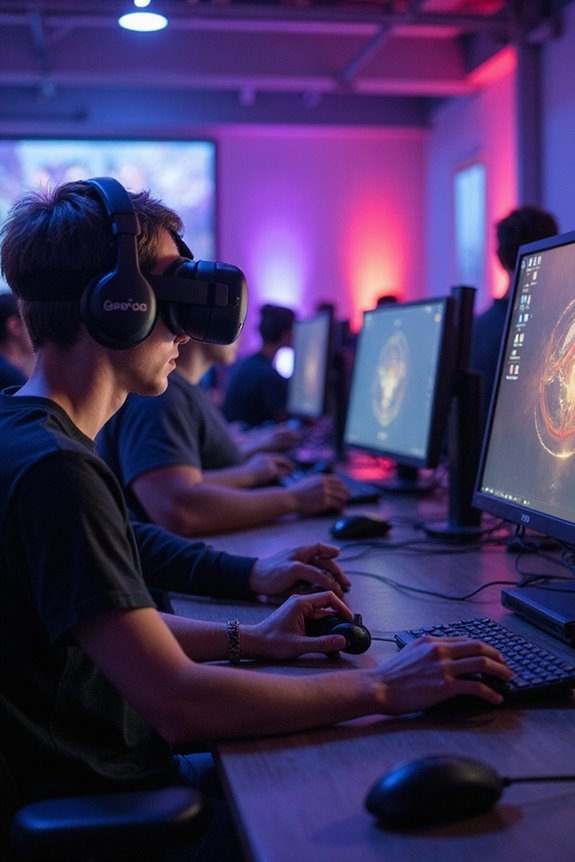Gaming truly is a digital playground revolution. With the global market forecast to hit $236.9 billion by 2025, advancements in tech like AR and VR are reshaping how we play. Mobile and cloud gaming make it easy for everyone to join in. Plus, the rise of eSports attracts gamers and spectators alike. While challenges like market saturation exist, the community is thriving. Stick around, and you’ll discover more about exciting trends and innovations shaping this vibrant world.
Key Takeaways
- The global gaming market is projected to reach $236.9 billion by 2025, driven by advancements in technology and increasing accessibility.
- Mobile gaming will account for 54% of revenues by 2025, reflecting a significant shift towards portable gaming experiences.
- Digital distribution platforms have transformed gaming access, offering vast libraries and instant downloads, reshaping how players engage with games.
- Cross-platform play fosters community connections, enabling gamers to interact and compete across different devices seamlessly.
- The rise of indie games and nostalgic remakes adds diversity and unique experiences to the gaming landscape, appealing to various demographics.
The Expanding Global Gaming Market
As the gaming industry continues to evolve, I can’t help but notice how the global market is expanding at an impressive rate. With projections suggesting it could reach $236.9 billion by 2025, the growth is fueled by technological advancements like AR and VR. The rise of mobile gaming and cloud platforms has made games accessible to millions, transforming how we play. It’s fascinating to see eSports driving engagement, attracting viewers and participants alike. Yet, while the numbers are staggering, it’s essential to recognize the challenges ahead, such as market saturation and shifting consumer preferences. Eco-friendly options in gaming accessories, like bamboo charging docks and biodegradable phone cases, are becoming increasingly important as gamers become more environmentally conscious. Still, the overall trajectory seems promising, hinting at a vibrant future for both gamers and developers. Let’s embrace this digital playground together!
Demographics of Gamers: Who Is Playing?

Understanding who’s playing video games today reveals a rich tapestry of demographics that goes beyond the stereotypical image of a solitary gamer. Around 80% of gamers are adults, with the 18-34 age group making up about 38%. It’s fascinating to see that even seniors, about 7%, are getting in on the fun. Geographically, over 1.5 billion gamers reside in the Asia Pacific, while Europe follows with 352 million.
What’s more, gaming isn’t just for the young; families and older adults are increasingly involved. The male-dominated stereotype is fading, too, as more women join the community. So, no matter your age or background, there’s a spot for you in this vibrant gaming world.
The Rise of Digital Distribution

The gaming landscape has seen a significant shift with the rise of digital distribution platforms, which are reshaping how we access and enjoy games. I can’t help but appreciate how these platforms, valued at over a billion dollars and growing, make it easier to immerse ourselves in new experiences. With high-speed internet and the convenience of instant downloads, who wouldn’t choose digital over physical copies?
Subscription models offer vast libraries for a flat rate, making gaming more affordable. Yet, I know there’s a downside—data security and reliance on stable connections can be tricky. Still, the community features, like integrated voice chat and co-op modes, have fostered connections that make gaming even more enjoyable. It’s a digital playground, and I’m here for it.
Platforms and Technologies Shaping Gaming

With the explosion of various gaming platforms and cutting-edge technologies, it’s hard not to marvel at how they’re transforming our gaming experiences. Mobile gaming is set to dominate, projected to account for 54% of revenues by 2025. Meanwhile, console gaming is growing faster than PC, which remains steady but slower. Cloud gaming is breaking barriers, making games accessible anywhere, while handheld devices like the Nintendo Switch keep attracting fans. Emerging technologies like VR and AR are enhancing immersion, and faster 5G networks mean smoother gameplay. Cross-platform gaming fosters community, allowing us to connect regardless of device. It’s a thrilling time in gaming, and while there are challenges, the potential for innovation feels endless. Additionally, USB hubs for Nintendo Switch offer expanded connectivity options, enhancing multiplayer experiences and portability for gamers on the go.
Innovative Monetization Strategies

Gaming’s evolution isn’t just about platforms and technologies; it’s also reshaping how developers think about monetization. Today, we see innovative strategies like in-app purchases, which let players buy items for real money, keeping engagement high. Subscriptions offer ongoing perks, while DLCs add fresh content to keep things exciting.
Battle passes bring seasonal challenges that reward commitment, blending fun with financial incentives. Ads, both banner and interstitial, offer brands a way to reach players without interrupting the experience too much.
I appreciate how hybrid models combine these elements, catering to diverse player preferences. Yet, while these strategies boost revenue, it’s vital to balance monetization with enjoyment to guarantee players feel valued, not just like wallets waiting to be opened.
Key Drivers of Industry Growth
Though the mobile market seems stagnant, improved global internet access is enhancing platform usage everywhere. Technological advancements play a huge role too; cloud gaming allows players to enjoy high-quality experiences without expensive hardware, while AR and VR technologies create immersive environments. Cross-platform play is uniting gamers across devices, fostering vibrant communities. Together, these elements are shaping a more engaging gaming landscape, even if the mobile scene has its limits. Additionally, advancements in AI-powered microphone technology are enhancing communication clarity in gaming headsets, providing an even more immersive experience for gamers.
Future Trends in Gaming
As the gaming landscape evolves, it’s clear that several future trends are shaping the way we play and interact with games. Cross-platform play is becoming essential, letting us enjoy games with friends no matter what device they use. I love seeing the rise of remakes and reboots; they bring nostalgia while minimizing risk for developers. Indie games are also gaining momentum, offering fresh ideas and unique experiences. Meanwhile, AI is stepping up to streamline game development and enhance gameplay. Plus, with next-gen hardware like the PS5 and Xbox Series X, we’re diving into visuals that pop. Finally, multiplayer focus boosts engagement, creating vibrant communities around our favorite titles. It’s an exciting time to be a gamer! Moreover, the advent of cloud gaming services is transforming accessibility, allowing gamers to enjoy high-quality experiences without the need for powerful hardware.
Redefining the Gamer Identity
In recent years, the identity of a gamer has transformed considerably, reflecting a broader spectrum of ages, genders, and backgrounds. It’s fascinating to see how 80% of gamers are now over 18, with a significant chunk being young adults. Gone are the days when gaming was just for young males; today, diverse age groups and nearly equal gender representation show just how inclusive our community has become. Technology plays a huge role here, making gaming accessible to everyone. Platforms like mobile and cloud gaming offer convenience, while cross-platform play enhances social connections. It’s heartening to know that gaming isn’t just about competition; it’s about forging friendships and sharing experiences across generations. Isn’t that what makes it truly special?
Frequently Asked Questions
How Do Gaming Companies Protect User Data and Privacy?
To safeguard our sensitive data, gaming companies employ encryption, regular updates, and multi-factor authentication. They’re endeavoring to build trust, ensuring our information’s protected, so we can enjoy our gaming experiences safely together.
What Are the Environmental Impacts of Gaming Hardware Production?
I’ve noticed that gaming hardware production markedly impacts our environment, from resource extraction causing pollution to energy-intensive manufacturing processes. It’s essential we acknowledge these effects and push for more sustainable practices in the gaming industry.
How Is Gaming Influencing Mental Health and Well-Being?
I once felt isolated until I discovered gaming communities. Gaming’s influence on mental health is profound; it can foster connections and offer stress relief, yet excessive play risks addiction and loneliness. Balance is key, right?
Are There Regulations Governing In-Game Purchases and Microtransactions?
Are there regulations for in-game purchases and microtransactions? Yes, there are! Different regions have unique rules, especially in the EU, emphasizing fairness and transparency. It’s essential to protect consumers like us from exploitative practices.
What Role Do Influencers Play in Promoting Video Games?
Influencers play a huge role in promoting video games. I’ve seen how their genuine enthusiasm connects with audiences, driving interest and sales. It’s fascinating how trust can transform a simple recommendation into a gaming phenomenon.




